Another in a series of postings on CBC captioning (also see the separate page on the topic)
In a delicious irony, a single caption on a CBC program has succeeded in epitomizing CBC captioners themselves:
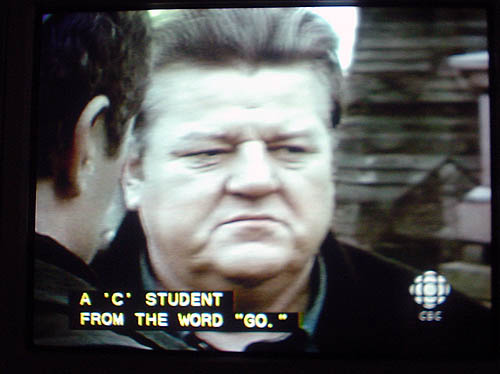
I present to you some excerpts from The Planman, a British telefilm (starring – inevitably – Robbie Coltrane) that reran on Friday night. Now, you’re thinking: If it’s a British production, the captioners can use British orthography, right? Well, in principle, yes, if a fully-considered and -researched system is in place. (Ditto U.S. spelling on American shows.) But don’t go looking for anything so recherché on the sixth floor of the CBC.
I surmise that what actually happens is this: Ferrets safely tucked away in their cages at home, CBC captioners trudge off to Fort Dork every day (ten in a row, then four days off). Their mission: To write down what people say on Canadian TV shows. Tedious in the extreme, obviously it’s a job that nobody in their right mind would ever opt into. To jazz things up a little, they pretend it was Brits who were doing the talking all along.
If The Planman uses British orthography, it’s by accident or by fiat (“British spelling is classy!”), not by choice.
But tell me: Isn’t a C student from the word go merely thus, and not a ‘C’ student from the word “go”?
More? Of course there is!
-
The en-dash character exists solely in the extended character set. By convention and after decades of experimentation, the correct substitute in the standard Line 21 character set is nospace-dash-dash-space. It certainly is not, as the CBC thinks, space-dash-space.

CBC is too inexperienced to understand what is likely to go wrong with such an orthography (and too defensive and stuck-up to ask).
-
“Clamour” with a U: Intentional Canadianism, unintentional Canadianism, or intentional anglicism?
![Caption: [loud clamour of reporters]](https://fawny.org/blog/images/CBC_captioning_Planman_clamour.jpg)
-
Does it not patronize the intelligent, informed, knowledgeable captioning viewer, especially one who isn’t too cheap to buy a good dictionary, to behave as though patronise is the correct spelling?
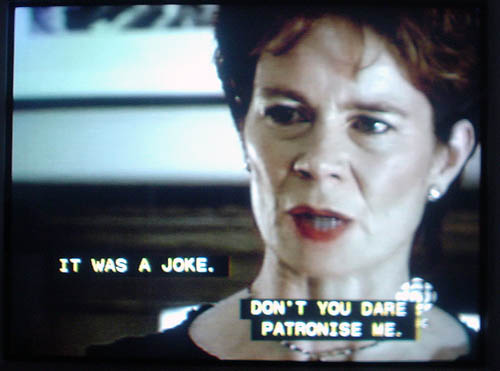
-
Would you feel safer if terrorised the British way or terrorized the Canadian way?
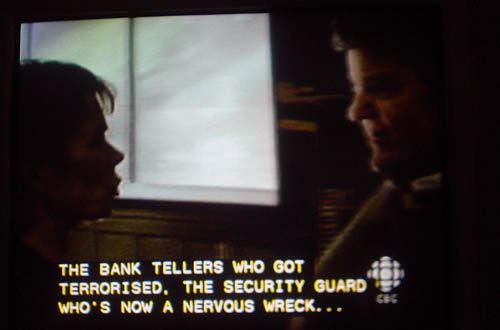
-
Oh, dear. Among the numerous spelling and typing errors in the program is this humdinger. Do you really think a schoolteacher’s “chalks” will keep an aircraft parked outside its hangar?
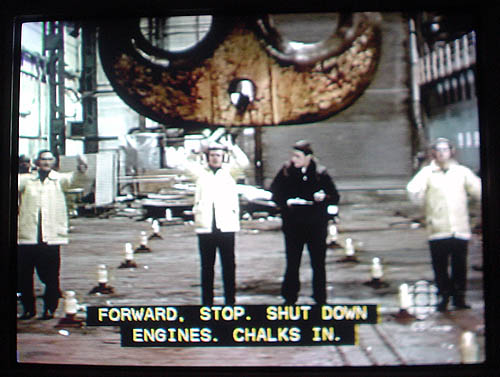
(Can I bang the erasers afterward?)
-
Who is this Damien “Hurst”? Is he a high-priced British artist or a non-union Mexican equivalent?

What kind of quotation marks does he use in his art?
-
I would like to be able to say that only CBC could manage to typeset a two-word caption of non-speech information on two separate lines. But CHUM does even worse than that.
![[scattered
applause] Caption: [scattered
applause]](https://fawny.org/blog/images/CBC_captioning_Planman_scattered.jpg)
-
I know it’s too much to ask, but might we find a double misuse of single quotation marks (in this case, for a periodical title, with errant comma positioning) and a misspelling all in a single caption?
At CBC, with its ongoing creative revitalization and focus on youth, anything is possible!
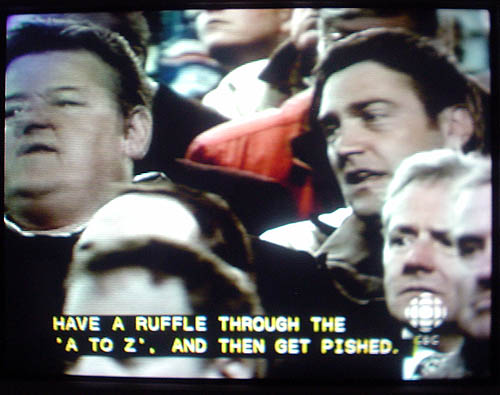
That’s a lot of problems in one show. (In fact, I have a list of other problems, including flagrantly insane caption breaks and of course the perennial SHOUTING IN CAPITAL LETTERS, but is life not too short?)
Can we at least run to the fridge during commercial breaks to escape the voluptuous horror of CBC captioning?
Nope.
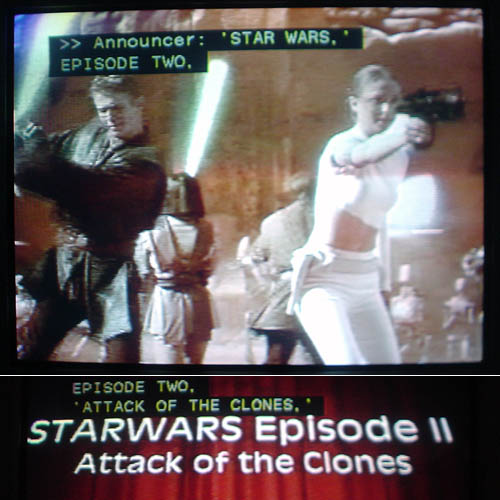
I saw that piece of shit – with captions and descriptions, and twice at that, once with a reporter from the Toronto Star – and I am pretty sure the title is Star Wars Episode II: Attack of the Clones. Other authorities, including the official site, render it differently; the Times used Star Wars: Episode II – Attack of the Clones. Nonetheless, four single quotation marks and two commas are not involved.
Superspecial hypocrisy alert
I was waiting for somebody to be smart enough or to care enough to righteously call me on my use of single quotes in headlines (like blog-post titles), Flickr photo descriptions, and some alt texts and photo cutlines. Surely such usage asserts a rank hypocrisy given the stated Canadian adoption of U.S. quotation-mark “style”?
Quite unlike going broke underestimating the American people, waiting for someone to notice this hypocrisy has been a mug’s game. So let me break it to you gently: Single quotes are used in such contexts across English dialects (check a newspaper sometime). There are similar cases, albeit few of them, like language glosses (e.g., in the sequence sous-titrage codé ‘closed captioning’).
But I don’t mean to overburden the reader. There are ever so many details to keep track of in our writing system; it’s all much too much for the frustrated teacher or the young woman with a bachelor’s in English that isn’t turning out to be as viable in the job market as she’d hoped. Surely it is an overreliance on detail that gets in the way of quick, inexpensive, and angrily and defensively created captioning.